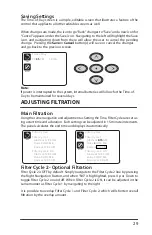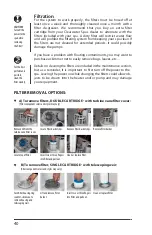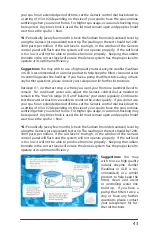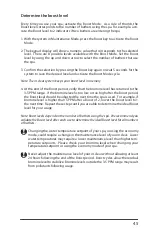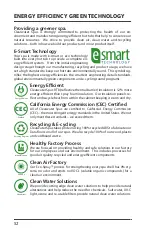
38
Usage Definitions
Before getting into how much and when, it is important to understand some of the
terminology that is used to describe how the chemicals are applied:
P.P.M. – Parts Per Million. Expressed as a ratio of number out of 1 million.
SHOCK – Addition of an oxidizer (OXY SHOCK) or superchlorinator to the water to
break-down the organic contaminates on which bacteria feed and to destroy am-
monia and nitrogen compounds (oxidize only).
SUPERCHLORINATION – Means the addition of enough chlorine in the water to kill
all living things (sanitize) and destroy any organic wastes present in the water (oxi-
dize). Usually this means about double your normal dose of chlorine. Superchlorina-
tion can be done once a day for heavy bather loads or as infrequent as once a week for
a moderately used spa.
CHLORINATION – To add chlorine to your spa on a regular basis to disinfect and
oxidize your spa water.
BREAK POINT CHLORINATION – The process of shocking the water with significant
quantities of chlorine to oxidize all contaminants and organic wastes and leave all
remaining chlorine as free chlorine.
CALCIUM HARDNESS – A measure of the amount of calcium dissolved in water. Wa-
ter with low hardness can lead to corrosion of metal parts. Water with high level of
hardness can cause scale (calcium crust) build up on spa surfaces and clog filters,
heaters and pumps.
WATER BALANCE – Water balance is reached when all elements (pH, total alkalinity,
calcium hardness and total dissolved solids) are within their proper ranges.
ENZYMES – Biodegradable proteins which breakdown oils, films and digest scum in
spa water.
FREE CHLORINE – The amount of chlorine available to kill bacteria or algae. Also
known as “Available Chlorine”.
COMBINED CHLORINE – The portion of the total chlorine in water in chemical com-
bination with ammonia, organics, and nitrogen, most of which are chloramines.
TOTAL ALKALINITY (TA) – The measure in PPM of all the dissolved
base/alkaline material in the water. The acid-neutralizing capacity of water which in-
dicates its buffering ability, or resistance to fluctuations in pH.
TOTAL DISSOLVED SOLIDS (TDS) – The total amount of dissolved materials in pool
or spa water. The ideal range is from 1,000 to 2,000 ppm in pools and 1,500 ppm
above the start-up TDS in spas.
Starting A Chemical Maintenance Program
A chemical maintenance program's goal is to maintain water balance. If you
apply chemicals and test your water on a regular basis, water balance is easy to
maintain and your spa water will stay clear and healthy.
Summary of Contents for Beachcraft Series
Page 57: ...57 NOTES...
Page 58: ...58 NOTES...






